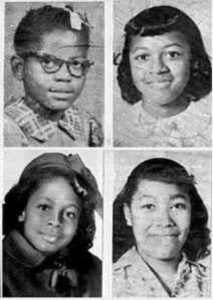 Today marks the 60th anniversary of the bombing of the Sixteenth Street Baptist Church in Birmingham, Alabama and the death of four young black girls, Addie Mae Collins, Cynthia Wesley, Carole Robertson and Carol Denise McNair. Birmingham was no stranger to bombings. Between 1947 and 1965 there for fifty separate bombings of homes, businesses, and churches in the town that came to be known as “Bombingham.”
Today marks the 60th anniversary of the bombing of the Sixteenth Street Baptist Church in Birmingham, Alabama and the death of four young black girls, Addie Mae Collins, Cynthia Wesley, Carole Robertson and Carol Denise McNair. Birmingham was no stranger to bombings. Between 1947 and 1965 there for fifty separate bombings of homes, businesses, and churches in the town that came to be known as “Bombingham.”
Even so, there was a sense of optimism in the summer of 1963. Earlier that year, Rev. Martin Luther King Jr’s. Southern Christian Leadership Conference led non-violent protests through the streets of Birmingham against segregation and discrimination. The protesters were met with violence from white supremacists like the Ku Klux Klan, as well as the Birmingham Police, led by Public Safety Commissioner Bull Connor. The police unleashed attack dogs on the protesters and sprayed them with fire hoses. The spectacle played out on TV, and is said to have sickened President John F. Kennedy, who just two months later introduced The Civil Rights Act of 1963. Despite the violence against them, the protest had been a success.
The optimism brought on by the introduction of The Civil Rights Act was short-lived. On September 15, 1963, four members of the United Klans of America planted fifteen sticks of dynamite, along with a timer, under the Sixteenth Street Baptist Church. The bomb went off as parishioners were gathering for the 11 o’clock service. A man driving past the church at the time of the blast was thrown completely out of his car. Another man, using a nearby pay phone, was blown through the door of a dry-cleaning business, still clutching the telephone’s ripped-off receiver in his hand.
The church itself was badly damaged, blowing out the back wall and leaving a massive crater where a large stone foundation and brick wall once stood. The four young girls, who had been changing into their Sunday clothes, were found in the basement. Cornell University Historian Kevin Kruse describes what happened next:
“As a crowd gathered to pull the girls’ bodies from the rubble of the church, a group of white teens with a Confederate flag and a sign saying “Go Back to Africa” taunted them. Some of African American teens responded by throwing stones, trying to chase them away from the scene. At this point, the police intervened and tried to apprehend some of the black teens. A sixteen-year-old black boy ran away from them, and was shot in the back by a shotgun blast.
“At the same time, across town, another pair of white boys pulled up alongside two young black boys who were riding their bikes. One of the white boys pulled out a pistol, put two bullets into a thirteen-year-old’s head and chest, and drove away.”
Today, sixty years after this horrendous and deadly violence, we see forces in our country that would like us to take a step back to those dark days. They want to reinstitute a caste system where African-Americans and other minorities are treated like second-class citizens. And they’re willing to use violence—just like the Ku Klux Klan and other white supremacists used in 1963—to get what they want.
It’s up to each of us to be diligent, to call out bigotry and hatred wherever and whenever it raises its ugly head. We’ve come too far and too much innocent blood has been spilled to ever go back. We must remember the lives lost on that fateful September day in 1963 and honor their memories by redoubling our efforts to end all forms of hatred and prejudice.
